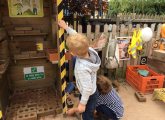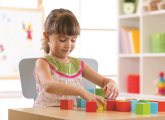A CHILD’S EYE VIEW
My very first teaching job was in a very special school in Northampton. Some of the children in my group were so severely disabled that the staff team had to move each child every 15 to 20 minutes to change their position. They would be placed in or on a different piece of equipment, beanbag or soft mattress with an assortment of mobiles and musical instruments within view or reach. Some of the mobiles had seen better days, and when I lay on one of the beanbags to tell a story with a puppet to a child, I realised how dull they looked and that they didn’t move. I wouldn’t fancy spending five minutes in that situation, let alone 20!
Over the next few days, I tried out every piece of equipment or position the children were placed in to see how interesting the surrounding area could be made for them. Prone boards and standing frames are unforgiving, but something fun, colourful or tuneful within reach, made 15 minutes more bearable.
I set about making some brighter mobiles with coloured foil and perspex that twinkled and moved with any slight breeze. The staff team decided to make some individual textured boards that made different sounds when touched or scratched. These fitted onto wheelchair trays as well as being able to hang on pegs. We collected small wind chimes that made delicate and tuneful sounds when they were touched, either accidentally or
on purpose.
I carried on thinking in this vane wherever I worked.
Child-friendly rooms
Our surroundings are important; we spend many hours in rooms with tables and chairs, carpets and cushions, cupboards and shelves, displays and noticeboards all around us, but usually we only notice things from our own perspective. I have mentioned in a previous article about the comfort of book corners. Eliminating draughts and cold spots can only happen if you experience them, so try kneeling and sitting on your heels in your preschool, where tables and chairs are at eye height. Are your displays as eye-catching from this angle? Do you get a crick in your neck trying to see something you want on a shelf? Does your room look crammed with things or is there a clear pathway through to an open space? Children love places to hide or feel safe in, but would you feel comfortable walking into a room where a cupboard half blocks your view?
I once showed a parent around our nursery and she commented that she felt the framed prints we had on the walls were difficult to look at comfortably: “I’m having to bend my knees to see them properly. Wouldn’t they be better higher up so they can be seen?” My reply was that they were for the children to look at and were at the correct height for them to observe detail, colour and shape. The mum smiled with pleasure: “Of course, this is a nursery!”
Worlds of imagination
Being in any preschool can bring surprises (the one above was a classic): usually, totally unexpected happenings that offer you an insight into a child’s thinking, so that you begin to see things from their perspective, understanding and viewpoint.
One afternoon in the garden, for example, I noticed four children dressed in a variety of outfits, sitting in a wooden rocking boat, playing a game they had devised. They were completely unaware of anything but themselves. There was a lot of shouting and chatter – “Watch out for that one.” “Smile and say green beans.” “Careful, it’s behind you.” “Look at those teeth!” – and I was intrigued. In the boat was Robin Hood being photographed by a clown with a doctor (armed with a stethoscope) giving an injection to another clown (so she wouldn’t be seasick). Apparently they were all on their way to France in shark and crocodile infested water. Life can be one big fantasy for many children attending a preschool, and their view on the world, where almost anything can happen, is often very different from ours.
Occasionally, however, their imaginations and lack of understanding can make life a horrible experience, so we need to be conscious of their needs…
We had dreadful draughts under one door at our nursery, where the carpet of the room met a vinyl floor in the corridor. The carpeted area was for small world floor play activities, and often the draught made playing on the floor uncomfortable. We attached a draught excluder roll to the base of the door so that the door could be opened and closed easily, but the draughts were prevented from getting under the door, making the whole room snug.
A couple of days after we had fitted the draught excluder, one little boy seemed extremely nervous when his best friend asked, “Are you coming with me to play in the sand? The dinosaurs are in there.” The sand pit was in another room along the corridor and was Sam and Ben’s favourite place. It suddenly dawned on the staff members in the imaginative play room that Sam hadn’t been anywhere else in the nursery since arriving that morning. His dad had left him happy and chirpy as usual, and, as far as the staff in the room were aware, he had been playing contentedly in the far corner of the room until that moment. When he was encouraged to go and play with Ben and the dinosaurs in the sand, Sam burst into tears and was obviously very emotional about the prospect. He kept looking at the draught excluder and became quite agitated when the door was opened and clung to the member of staff who was consoling him. Then Sam shouted, “Please shut the door – don’t let the little draughts in!”
A cautionary tale
Sam had asked, soon after his arrival at nursery, what the thing at the bottom of the door was. He had been told it was called a
draught excluder and that it stopped annoying little draughts from coming under the door. He had, in his imagination, transformed
the explanation into little creatures that were getting more and more annoyed because they couldn’t get into the room. He thought these draughts were waiting in the corridor to come into the room. If he opened the door to go elsewhere, they would all rush in, knock him over and take over the room!
After taking the draught excluder from the bottom of the door and allowing him (and the rest of the group) to feel the ‘wind’ under the door, demonstrating that the draughts were just moving air currents, Sam felt that the dinosaurs in the sand would be more fun, and off he went without a second glance at the annoyed little draughts.
Nurseries and preschools are richer and more enjoyable environments when we, as practitioners, take the trouble to look at things from a child’s point of view – whether it is the way our rooms are organised, or our words might be interpreted by a creative mind. As an unknown source said, “To get to know someone, walk a mile in their shoes”.

Early years reading – Take story time on screen
Editors picks

Mark making EYFS – How to prepare children
Editors picks

STEAM learning – Teaching it in Early Years
Editors picks

Observations – using a strengths-based approach
Editors picks
